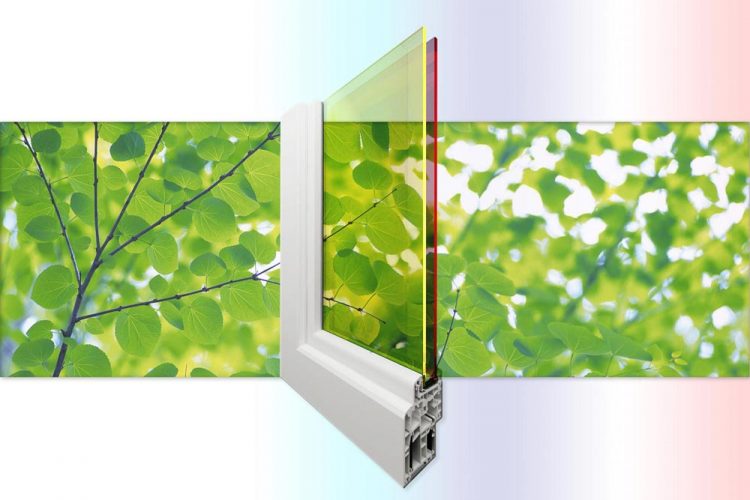Tweaking quantum dots powers-up double-pane solar windows

Researchers at Los Alamos National Laboraotry are creating double-pane solar windows that generate electricity with greater efficiency and also create shading and insulation. It's all made possible by a new window architecture which utilizes two different layers of low-cost quantum dots tuned to absorb different parts of the solar spectrum. The approach complements existing photovoltaic technology by adding high-efficiency sunlight collectors to existing solar panels or integrating them as semitransparent windows into a building's architecture. Credit: Los Alamos National Laboratory
Using two types of “designer” quantum dots, researchers are creating double-pane solar windows that generate electricity with greater efficiency and create shading and insulation for good measure. It's all made possible by a new window architecture which utilizes two different layers of low-cost quantum dots tuned to absorb different parts of the solar spectrum.
“Because of the the strong performance we can achieve with low-cost, solution-processable materials, these quantum-dot-based double-pane windows and even more complex luminescent solar concentrators offer a new way to bring down the cost of solar electricity,” said lead researcher Victor Klimov.
“The approach complements existing photovoltaic technology by adding high-efficiency sunlight collectors to existing solar panels or integrating them as semitransparent windows into a building's architecture.”
The key to this advance is “solar-spectrum splitting,” which allows one to process separately higher- and lower-energy solar photons. The higher-energy photons can generate a higher photovoltage, which could boost the overall power output. This approach also improves the photocurrent as the dots used in the front layer are virtually “reabsorption free.”
To achieve this, the Los Alamos team incorporates into quantum dots ions of manganese that serve as highly emissive impurities. Light absorbed by the quantum dots activates these impurities. Following activation, the manganese ions emit light at energies below the quantum-dot absorption onset. This trick allows for almost complete elimination of losses due to self-absorption by the quantum dots.
To transform a window into a tandem luminescent sunlight collector, the Los Alamos team deposits a layer of highly emissive manganese-doped quantum dots onto the surface of the front glass pane and a layer of copper indium selenide quantum dots onto the surface of the back pane. The front layer absorbs the blue and ultraviolet portions of the solar spectrum, while the rest of the spectrum is picked up by the bottom layer.
Following absorption, the dot re-emits a photon at a longer wavelength, and then the re-emitted light is guided by total internal reflection to the glass edges of the window. There, solar cells integrated into the window frame collect the light and convert it to electricty.
###
Publication: Kaifeng Wu, Hongbo Li, and Victor I. Klimov, Tandem luminescent solar concentrators based on engineered quantum dots, Nature Photonics, DOI 10.1038/s41566-017-0070-7, January 1, 2018.
Project members: Kaifeng Wu (Director's Postdoctoral Fellow), Hongbo Li (Postdoctoral Research Associate, Victor I. Klimov (Laboratory Fellow, Project Leader).
Acknowledgements: This work was supported by the Center for Advanced Solar Photophysics (CASP), an Energy Frontier Research Centre funded by the U.S. Department of Energy, Office of Science, Basic Energy Sciences
About Los Alamos National Laboratory
Los Alamos National Laboratory, a multidisciplinary research institution engaged in strategic science on behalf of national security, is operated by Los Alamos National Security, LLC, a team composed of Bechtel National, the University of California, BWX Technologies, Inc. and URS Corporation for the Department of Energy's National Nuclear Security Administration.
Los Alamos enhances national security by ensuring the safety and reliability of the U.S. nuclear stockpile, developing technologies to reduce threats from weapons of mass destruction, and solving problems related to energy, environment, infrastructure, health and global security concerns.
Media Contact
All latest news from the category: Materials Sciences
Materials management deals with the research, development, manufacturing and processing of raw and industrial materials. Key aspects here are biological and medical issues, which play an increasingly important role in this field.
innovations-report offers in-depth articles related to the development and application of materials and the structure and properties of new materials.
Newest articles

A ‘language’ for ML models to predict nanopore properties
A large number of 2D materials like graphene can have nanopores – small holes formed by missing atoms through which foreign substances can pass. The properties of these nanopores dictate many…

Clinically validated, wearable ultrasound patch
… for continuous blood pressure monitoring. A team of researchers at the University of California San Diego has developed a new and improved wearable ultrasound patch for continuous and noninvasive…

A new puzzle piece for string theory research
Dr. Ksenia Fedosova from the Cluster of Excellence Mathematics Münster, along with an international research team, has proven a conjecture in string theory that physicists had proposed regarding certain equations….



